THE INDIAN ART, CULTURE AND HERITAGE
-
DURGA PUJA GETS INTANGIBLE CULTURAL HERITAGE TAG
THE CONTEXT: Durga Puja in Kolkata, one of largest cultural carnivals and street art festival of the country, received an important international recognition by making it to UNESCO’s Representative List of the Intangible Cultural Heritage of Humanity.
THE EXPLANATION:
- Kolkata’s Durga Puja festival has become the latest event to be inscribed in the ‘Representative List of the Intangible Cultural Heritage of Humanity’ by the United Nations Educational, Scientific and Cultural Organisation (UNESCO).
- With this, festival becoming the new addition in the ‘Intangible Cultural Heritage’ list by the UNESCO, India now has a total of 14 events that represent the country’s tradition and culture in it.
- An annual festival, Durga Puja is celebrated in different parts of the country, but most notably in Kolkata. It marks the ten-day worship of goddess Durga which involves artisanal sculptures of the goddess sculpted from clay pulled from the Ganga.
UNESCO’s ‘Intangible Cultural Heritage of Humanity’ list
- The list is made up of those intangible heritage elements that help demonstrate diversity of cultural heritage and raise awareness about its importance.
- The list was established in 2008 when Convention for Safeguarding of the Intangible Cultural Heritage came into effect.
- UNESCO maintains three lists under its “Intangible Cultural Heritage” banner: the list of intangible cultural heritage in need of urgent safeguarding, the list of the intangible cultural heritage of humanity and the register of good safeguarding practices.
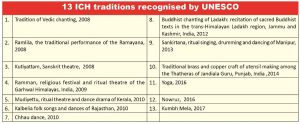
- Some of the criteria for inclusion in the representative list are if the inscription of the element will ensure visibility and awareness of it and if the element has been nominated after having “the widestpossible participation” of the community, group or individuals concerned and with their free, prior and informed consent.
THE INDIAN POLITY AND GOVERNANCE
2. DEMAND FOR INCLUSION OF LADAKH IN THE SIXTH SCHEDULE
THE CONTEXT: Recently, a Member of Parliament from Ladakh demanded that the region be included in the Sixth Schedule of the Constitution to safeguard land, employment, and cultural identity of the local population.
THE EXPLANATION:
What is the Sixth Schedule?
- The Sixth Schedule under Article 244 provides for the formation of autonomous administrative divisions — Autonomous District Councils (ADCs) — that have some legislative, judicial, and administrative autonomy within a state.
 with more than 40 members and the right to make laws on 39 issues.
with more than 40 members and the right to make laws on 39 issues.- ADCs have up to 30 members with a term of five years, and can make laws, rules and regulations with regard to land,forest, water, agriculture, village councils, health, sanitation, village- and town-level policing, inheritance, marriage and divorce, social customs and mining, etc.
- The Bodoland Territorial Council in Assam is an exception
The Sixth Schedule applies to the Northeastern states of Assam, Meghalaya, Mizoram (three Councils each), and Tripura (one Council).
Why does Ladakh want to be part of the Sixth Schedule?
There was much enthusiasm initially, mostly in Leh, after the August 5, 2019 decisions that created two new Union Territories. Buddhist-dominated Leh district had long demanded UT status because it felt neglected by the erstwhile state government, which was dominated by politicians from Kashmir and Jammu.
The UT has two Hill councils in Leh and Kargil, but neither is under the Sixth Schedule. Their powers are limited to collection of some local taxes such as parking fees and allotment and use of land vested by the Centre.
Voices from the ground:
In Kargil district, which is dominated by Shia Muslims, demands have been raised for the restoration of special status — also for a merger with the UT of J&K which has been provisioned a legislature. Representatives of social, religious, and political groups in Kargil have come together under the banner of the KDA.
Can Ladakh be included in Sixth Schedule?
In September 2019, the National Commission for Scheduled Tribes recommended the inclusion of Ladakh under the Sixth Schedule, noting that the new UT was predominantly tribal (more than 97%), people from other parts of the country had been restricted from purchasing or acquiring land there, and its distinct cultural heritage needed preservation.
Notably, no region outside the Northeast has been included in the Sixth Schedule. In fact, even in Manipur, which has predominantly tribal populations in some places, the autonomous councils are not included in the Sixth Schedule.Nagaland and Arunachal Pradesh, which are totally tribal, are also not in the Sixth Schedule.
According to Home Ministry. “The Ladakh’s inclusion in the Sixth Schedule would be difficult. The Constitution is very clear, Sixth Schedule is for the Northeast. For tribal areas in the rest of the country, there is the Fifth Schedule”.
However, it remains the prerogative of the government — it can, if it so decides, bring a Bill to amend the Constitution for this purpose.
THE ENVIRONMENT AND ECOLOGY
3. HIMACHAL PRADESH PUSHING TOWARDS WATER INSECURITY
THE CONTEXT: According to a report by the State Centre on Climate Change Shimla and Space Application Centre of the ISRO in Ahmedabad said, that the Himachal Pradesh, a state that has five important perennial rivers fed particularly by glaciers, has witnessed a decline in snowfall over the past year. The area under snow cover in the state has declined by 18.5% between 2019-’20 and 2020-’21.
THE EXPLANATION:
- The study revealed that the area under snow cover in 2019-’20 was 23,542 sq km, which dropped to 19,183 sq km in 2020-’21, a decline of 3,404 sq km or 18.52%. Usually, in the winter season, about one-third of the geographical area of the state, which amounts to about 18,556 sq km, remains under thick snow cover.
- Most of the major rivers like Chenab, Beas, Parvati, Baspa, Spiti, Ravi, Sutlej andtheir perennial tributaries originating from the Himalayas depend upon the seasonal snow cover for their discharge dependability.
- Also, the centre noted, they observed a shift in snowfall patterns in the last few years and snow cover is continuously declining “. They also observed a decreasing trend in four river basins of the state which put long-term implications on water availability in the river basins.
Falling snow cover
The report added that the snow cover in the Chenab basin fell from 7,154 sq km in 2019-’20 to 6,516 sq km in 2020-’21, a reduction of 638 sq km or 8.92%. The Beas basin shows a decrease of about 19% with its average snow cover area having decreased from 2,458 sq km to 2,002 sq km, a loss of 455 sq km. The Ravi basin saw an overall reduction of 23% in the total area under snow cover.
The snow cover in the Sutlej Basin, which covers 45% area of Himachal and is the longest river in the state, shrunk the most by 23.49% or 2,777 sq km. It was 11,823 sq km in 2019-’20 and 9,046 sq km this year.
Another study published in 2019 said that the Sutlej River basin glaciers are melting fast and may shrink significantly by as soon as 2050. The research estimates that the melting would cause 33% of the glaciers to disappear by 2050 and 81% by the end of the century.
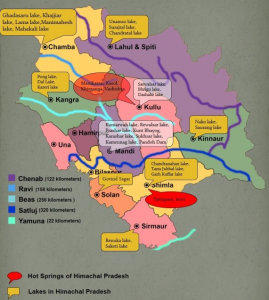
Melting glaciers
Not only Himachal, glaciers in Jammu, Kashmir and Ladakh are also melting at a significant rate. According to a 2020 study, over 1,200 glaciers in the region saw an annual reduction in mass of 35 centimetres on average between 2000 and 2012. The study added that the glaciers have reduced from 102 sq km in 1980 to 72 sq km in 2018 showing a recession 28.8% decrease.
The Ganges River system in the Indian Himalayas can be divided into four major river basins i.e the Yamuna, Bhagirathi, Alaknanda and Ghaghara River Basins. The Ganges River system remains the main source of fresh water for half the population of India and Bangladesh and nearly the entire population of Nepal. Reports also mention a decline in snow cover of the Brahmaputra basin.
According to a study Glacio-hydrology of the Himalaya-Karakoram by Ministry of Science and Technology, snow and glaciers are melting rapidly in the Himalayan range due to climate change, altering water supplies in the rivers like Indus, Ganga and Brahmaputra in the Himalaya-Karakoram ranges. Total river runoff, glacier melt and seasonality of flow in these rivers are projected to increase until the 2050s, with some exceptions and large uncertainties.
Panchprayag:
The five holy places of PanchPrayag include:
- Vishnuprayag = Alaknanda +Dhauli Ganga
- Nandprayag = Alaknanda + Nandakini
- Karnaprayag = Alaknanda + Pinderi
- Rudraprayag = Alaknanda + Mandakini
- Devprayag = Alaknanda + Bhagirathi\
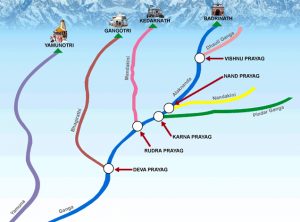
- THE PUSH FOR ZERO BUDGET NATURAL FARMING
THE CONTEXT:The Prime Minister highlighted the importance of Zero Budget Natural Farming and, he called for the method to become a mass movement.
THE EXPLANATION:
- According to the Agriculture Ministry, the Centre has sanctioned support for converting four lakh additional hectares of crop land in eight States to using ZBNF techniques. This is meant to provide a showcase for their benefits although scientific studies on the method have not yet been completed.
What is Zero Budget Natural Farming?
ZBNF is a method of chemical-free agriculturedrawing from traditional Indian practices. It was originally promoted by agriculturist and Padma Shri recipient Subhash Palekar, who developed it in the mid-1990s as an alternative to the Green Revolution’s methods driven by chemical fertilizers, pesticides and intensive irrigation.
What is it and how did it come about?
According to Subhash Palekar, he argued that the rising cost of these external inputs was a leading cause of indebtedness and suicide among farmers, while the impact of chemicals on the environment and on long-term fertility was devastating. Without the need to spend money on these inputs — or take loans to buy them — the cost of production could be reduced, and farming made into a “zero budget” exercise, breaking the debt cycle for many small farmers.
What is the method?
- Instead of commercially produced chemical inputs, ZBNF promotes the application of jivamrita — a mixture of fresh cow dung and aged cow urine, jaggery, pulse flour, water, and soil — on farmland.
- This is a fermented microbial culture that adds nutrients to the soil and acts as a catalytic agent to promote the activity of microorganisms and earthworms in the soil. About 200 litres of jivamritashould be sprayed twice a month per acre of land; after three years, the system is supposed to become self-sustaining.
- Only one cow is needed for 30 acres of land, according to Mr. Palekar, with the caveat that it must be a local Indian breed — not an imported Jersey or Holstein.
A similar mixture, called bijamrita, is used to treat seeds, while concoctions using neem leaves and pulp, tobacco and green chillis are prepared for insect and pest management.
The ZBNF method also promotes soil aeration, minimal watering, intercropping, bunds and topsoil mulching and discourages intensive irrigation and deep ploughing. Mr. Palekar is against vermicomposting, which is the mainstay of typical organic farming, as it introduces the most common composting worm, the European red wiggler (Eisenia fetida) to Indian soils. He claims these worms absorb toxic metals and poison groundwater and soil.
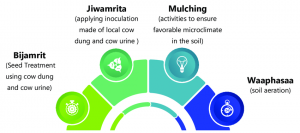
Is it effective?
A limited 2017 study in Andhra Pradesh claimed a sharp decline in input costs and improvement in yields. However, reports also suggest that many farmers, including from Mr. Palekar’s native Maharashtra, have reverted to conventional farming after seeing their ZBNF returns drop after a few years, in turn raising doubts about the method’s efficacy in increasing farmers’ incomes.
ZBNF critics, including some experts within the central policy and planning think tank NITI Aayog, note that India needed the Green Revolution in order to become self-sufficient and ensure food security. They warn against a wholesale move away from that model without sufficient proof that yields will not be affected. Sikkim,(First organic state in India) which has seen some decline in yields following a conversion to organic farming, is used as a cautionary tale regarding the pitfalls of abandoning chemical fertilizers.
|
The burden of fertiliser subsidy Fertiliser subsidy in the country amounting to close to INR 79,960 crore in 2019-20 constitutes a sizeable portion of the government’s agricultural subsidies. The urea subsidy alone corners more than 60 percent of the allocation, the rest being nutrient-based subsidies. The total outlay on fertiliser subsidies in 2017–18 in Andhra Pradesh alone is INR 3,485 crore. |
Which are the States with big plans?
The Centre has sanctioned the proposals of eight States for support under the Paramparagat Krishi Vikas Yojana scheme. Andhra Pradesh has the biggest ambition to bring one lakh additional hectares of land under ZBNF under the scheme, followed by Chhattisgarh, with 85,000 additional hectares and Gujarat, with 71,000 additional hectares.
Need of the hour:
While harnessing the advantages of the prescribed natural inputs, it is also important to explore the feasibility of alternatives in case of inaccessibility to critical inputs. Considering the Government’s interest in promoting ZBNF at the national level, the extent of its sustainability needs to be critically monitored in the next few years. An extensive study with a larger sample size and a few demonstration units in small pockets of monitored agricultural land is recommended.
As the prescribed guidelines for ZBNF are similar for all crops and agro-climatic conditions, the single-solution applicability of natural ingredients needs to be tested for all crops and soil types. Close monitoring of the soil health during and after transition would allow us to understand the long-term impact of the practice.
THE INDIAN ECONOMY
- THE PCA FRAMEWORK FOR NBFC
THE CONTEXT: The Reserve Bank of India (RBI) introduced a prompt corrective action (PCA) framework for large non-banking financial companies (NBFCs), putting restrictions on para-banks whenever vital financial metrics dip below the prescribed threshold.
THE EXPLANATION:
- This brings them almost on a par with banks in terms of supervision and regulatory reach. This follows the scale-based regulations and revision in non-performing asset (NPA) norms brought in by the regulator for the sector.
- The PCA framework for NBFCs comes into effect on October 1 next year on the basis of their financial position on or after March 31. It will be applicable for all deposit-taking NBFCs and other large ones that sit in the middle, upper, and top layers of the central bank’s scale-based regulation for the sector.
- However, those not taking deposits and with an asset size of less than Rs 1,000 crore, primary dealers, government owned NBFCs, and housing finance companies are exempt from this framework.
- This will, therefore, be applicable for only a few NBFCs while the vast majority of the nearly 10,000 such entities will be excluded. However, the central bank can take any action irrespective of the size of an NBFC.
- The central bank cited the growing size of the NBFC sector and “substantial interconnectedness with other segments of the financial system” as the reason for the PCA framework. It said it would further strengthen the supervisory tools for NBFCs.
- According to RBI, the objective of the PCA Framework is to enable supervisory intervention at appropriate time and require the supervised entity to initiate and implement remedial measures in a timely manner, so as to restore its financial health”.
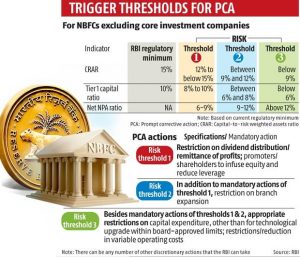
What is Prompt Corrective Action (PCA)?
- PCA is a framework under which banks with weak financial metrics are put under watch by the RBI.
- The RBI introduced the PCA framework in 2002 as a structured early-intervention mechanism for banks that become undercapitalised due to poor asset quality, or vulnerable due to loss of profitability.
- It aims to check the problem of Non-Performing Assets (NPAs) in the Indian banking sector.
- The framework was reviewed in 2017 based on the recommendations of the working group of the Financial Stability and Development Council on Resolution Regimes for Financial Institutions in India and the Financial Sector Legislative Reforms Commission.
- INDIA LOSES WTO DISPUTE OVER SUGAR-EXPORT SUBSIDIES
THE CONTEXT: A World Trade Organization panel ruled that India violated international trade rules when it offered excessive subsidies for the production and export of sugar and sugarcane.
THE EXPLANATION:
- According to WTO, India’s policies were inconsistent with WTO rules that govern the levels at which nations can subsidize domestic agricultural production. Under WTO rules, India’s sugar subsidies are capped at a de minimis limit of 10% of the value of production.
- India — the world’s largest sugar producer after Brazil — has already pledged to refrain from subsidizing sugar exports this year due to high global prices. The government previously approved a subsidy of $475 million for the 2020-2021 growing season.
The dispute dates back to 2019 when Brazil, Australia and Guatemala filed parallel WTO complaints that alleged the Indian government massively increased its sugar subsidies and reintroduced a minimum price for sugar, which led to increased production of sugar that outstripped domestic demand.
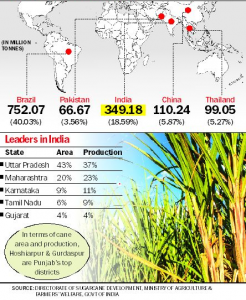
According to Brazil’s complaint, during the 2018-2019 growing season, India approved dozens of federal and state-level assistance programs for the sugar industry that collectively exceeded 55 billion rupees ($730 million).
India’s response:
- The findings of the WTO panel are “completely unacceptable,” India’s commerce ministry said in a statement adding its measures on sugar are consistent with its obligations under WTO agreements.
- “India has initiated all measures necessary to protect its interest and file an appeal at the WTO against the report, to protect the interests of its farmers”.
WTO Agreement on Agriculture:
AoA is aimed to remove trade barriers and to promote transparent market access and integration of global markets. Agreement on agriculture has three components:
- Domestic Support: It aims for reduction in domestic subsidies that distorts free trade and fair price.
Under this provision, the Aggregate Measurement of Support (AMS) is to be reduced by 20% over a period of 6 years by developed countries and 13% over a period of 10 years by developing countries.
Under this, Subsidies are categorized into three parts:
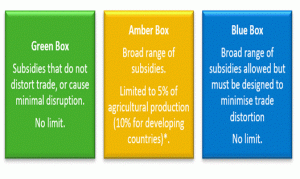
- Market Access: It requires that tariffs fixed (like custom duties) by individual countries be cut progressively to allow free trade. It also required countries to remove non-tariff barriers and convert them to Tariff duties.
- Export Subsidy: Subsidy on agriculture inputs or making export cheaper or other incentives for exports such as import duty remission etc are included under export subsidies. These can result in dumping of highly subsidized (and cheap) products in other countries and damage the domestic agriculture sector of other country.
- UNION CABINET APPROVES ₹76,000 CRORE PUSH FOR SEMICONDUCTOR MAKERS
THE CONTEXT: In an attempt to push Semiconductor manufacturing within the country, the Union Cabinet,cleared a Rs 76,000 crore production-linked incentive scheme (PLI) for semiconductor and display manufacturers to make the country an electronic system design and manufacturing global hub.
THE EXPLANATION:

- According to the government, it proposes to provide incentives worth Rs 76,000 crore for semiconductor production over the next six years.
- “The programme will usher in a new era in electronics manufacturing by providing a globally competitive incentive package to companies in semiconductors and display manufacturing as well as design”.
- The PLI scheme will provide monetary support of up to 50% of the project cost for setting up semiconductor and display fabrication units in the country. Moreover, the government noted that the Centre will work with the States to set up high-tech clusters with the necessary infrastructure such as land and semiconductor-grade water.
What is the need?
Semiconductors and displays are the foundation of modern electronics driving the next phase of digital transformation under Industry 4.0. Semiconductors and display manufacturing is very complex and technology-intensive sector involving huge capital investments, high risk, long gestation and payback periods, and rapid changes in technology, which require significant and sustained investments.
- The program will give an impetus to semiconductor and display manufacturing by facilitating capital support and technological collaborations.
- The programme aims to provide attractive incentive support to companies / consortia that are engaged in Silicon Semiconductor Fabs, Display Fabs, Compound Semiconductors / Silicon Photonics / Sensors (including MEMS) Fabs, Semiconductor Packaging (ATMP / OSAT), Semiconductor Design.
Following broad incentives have been approved for the development of semiconductors and display manufacturing ecosystem in India:

Semi-conductor Laboratory (SCL): Union Cabinet has also approved that Ministry of Electronics and Information Technology will take requisite steps for modernization and commercialization of Semi-conductor Laboratory (SCL).MeitY will explore the possibility for the Joint Venture of SCL with a commercial fab partner to modernize the brownfield fab facility.
Compound Semiconductors / Silicon Photonics / Sensors (including MEMS) Fabs and Semiconductor ATMP / OSAT Units: The Scheme for Setting up of Compound Semiconductors / Silicon Photonics / Sensors (including MEMS) Fabs and Semiconductor ATMP / OSAT facilities in India shall extend fiscal support of 30% of capital expenditure to approved units. At least 15 such units of Compound Semiconductors and Semiconductor Packaging are expected to be established with Government support under this scheme.
Semiconductor Design Companies: The Design Linked Incentive (DLI) Scheme shall extend product design linked incentive of up to 50% of eligible expenditure and product deployment linked incentive of 6% – 4% on net sales for five years.
India Semiconductor Mission: In order to drive the long-term strategies for developing a sustainable semiconductors and display ecosystem, a specialized and independent “India Semiconductor Mission (ISM)” will be set up. The India Semiconductor Mission will be led by global experts in semiconductor and display industry. It will act as the nodal agency for efficient and smooth implementation of the schemes on Semiconductors and Display ecosystem.
Significance:
- In the current geopolitical scenario, trusted sources of semiconductors and displays hold strategic importance and are key to the security of critical information infrastructure. The approved program will propel innovation and build domestic capacities to ensure the digital sovereignty of India. It will also create highly skilled employment opportunities to harness the demographic dividend of the country.
- Development of semiconductor and display ecosystem will have a multiplier effect across different sectors of the economy with deeper integration to the global value chain. The program will promote higher domestic value addition in electronics manufacturing and will contribute significantly to achieving a USD 1 Trillion digital economy and a USD 5 Trillion GDP by 2025.
BACKGROUND:
What is a Semiconductor?
- A semiconductor material is defined by its ability to conduct electricity and its conductivity properties lie between conductor and insulator.
- Under specific conditions, Semiconductors have the ability to act either as a pure conductor or a pure insulator.
- Examples of Semiconductor materials are Silicon, Germanium, Gallium Arsenide etc., where Silicon is the most commonly used.
- Gallium arsenide stands as the second-best semiconductor material and is used in solar cells, laser diodes, microwave frequency integrated circuits etc.

THE PRELIM PRACTICE QUESTION
1.Consider the following are in the UNESCO intangible heritage sites:
- Kuttiyattam
- Nowruz
- Holi
- Kalbelia
Which of the statements given above are incorrect?
a) 1 and 2 only
b) 2 and 3 only
c) 1 and 3 only
d) None
ANSWER FOR 13TH DECEMBER 2021 PRELIMS PRACTICE QUESTIONS
Answer: c)
Explanation:
- Statement 1 is correct: WPI measures inflation at the first stage of transaction i.e. at wholesale level.
- Statement 2 is correct: It is compiled by Office of Economic Advisor in DIPP, in Ministry of Commerce & Industry.
- Statement 3 is incorrect: It measures inflation on a year-on-year basis.

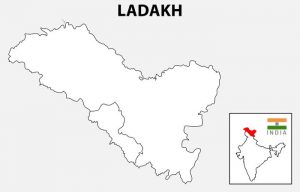 with more than 40 members and the right to make laws on 39 issues.
with more than 40 members and the right to make laws on 39 issues.
